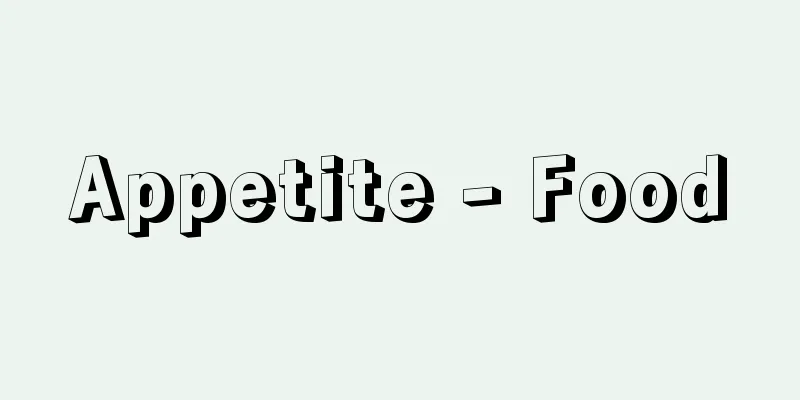Appetite - Food

|
Along with thirst and sleep, hunger is an innate, primary need related to the preservation of the individual organism. The physiological mechanism that senses appetite is said to be located in the hypothalamus of the brain, and is directly and indirectly related to nutrient deficiencies, increased blood sugar release, and gastric contractions. A psychological challenge is how to position hunger (a visceral sensation) and appetite in the narrow sense (the motivation for eating behavior) according to the mechanism of physiological imbalance and recovery that inevitably occurs due to metabolism. Taste is an important factor in appetite, and whether or not it is used as an intermediary will affect food intake even in the same physiological state of deficiency. If food is directly injected into the stomach through a tube, intake is lower than when food is eaten by tasting it through the mouth. Foods are selected according to taste preferences, which vary by species and individual organism, as well as by the state of nutrient deficiency. As deficiency progresses, the range of food choices expands, and when full, it narrows in favor of tastier foods. Preferences also change qualitatively depending on the level of deficiency, and the order of selection may change. A state of deficiency based on metabolism is called general starvation, while a state of deficiency in a specific nutrient is called specific starvation. In general starvation, many foods are replaceable, but in specific starvation, this is not possible, and this restriction puts survival at risk. Furthermore, specific starvation does not necessarily result in the appetite required to recover from malnutrition. A state of specific starvation can occur due to selective eating based on one's own preferences, and the individual may find it difficult to escape and remain in a pathological condition. Furthermore, an animal experiment showed that in the case of specific starvation, rather than actively seeking foods that will recover from malnutrition, the individual will exhibit eating behavior that avoids only the foods that have caused malnutrition (specific aversion). In the case of humans, preferences change depending on differences in culture, environment, etc. Some cultures like rice or wheat as their staple food, and some like raw fish and insects and others dislike them. Appetite, as well as taste, is strongly regulated by eating habits. In humans, general hunger usually dictates eating two or three times a day, and this habit conditions appetite, which in turn controls physiological states. Recently, experimental results have also shown that obese people eat all the food in front of them at mealtimes, regardless of the amount, making it difficult for them to adjust their appetite based on physiological needs. Appetite affects other desires and emotions, and is in turn affected by other desires and emotions. When full, people generally feel satisfied and tend to have an optimistic attitude, but when hunger intensifies, they may exhibit aggressive behavior that lacks social manners or become depressed. Conversely, appetite decreases when in a state of anxiety or fear, and increases and decreases during pregnancy and childbirth, and preferences also change. The relationship between deprivation and hunger is also complex; after fasting, hunger peaks after three or four days, but then gradually decreases and one may experience a loss of appetite. [Takashi Ogawa] Appetite developmentCurrently, as a result of experiments on stimulating and destroying the brain in animals, it is known that the neurophysiology of appetite is controlled by the activity of two appetite centers: the satiety center in the ventromedial nucleus of the hypothalamus of the diencephalon (corresponding to the back of the nose), and the feeding center in the lateral hypothalamic area. In other words, stimulating an animal's feeding center will make it eat food, and stimulating the satiety center will make it stop eating even in the middle of eating food. Conversely, destroying the feeding center will make the animal stop eating and become thin, while destroying the satiety center will make it eat more and become obese. The activity of these two centers is such that when one is increased, the other is suppressed. The nerve cells in these appetite centers are sensitive to glucose, insulin, and free fatty acids in the blood, and appetite is regulated according to their blood concentrations. Furthermore, these two centers are also influenced by stimuli from the external environment, such as vision, taste, and smell, as well as the functions of the cerebral cortex, such as emotions, thoughts, and past memories. [Tetsuya Nakagawa] Appetite disordersAppetite disorders include increased appetite, loss of appetite, and peculiar taste disorders. [Tetsuya Nakagawa] Increased appetiteIncreased appetite can lead to bulimia or binge eating, or so-called overeating. An appetite is easily stimulated when eating tasty or favorite foods, or when enjoying a meal with others. Moderate exercise and work also help to increase appetite. Furthermore, appetite often increases during the cool autumn months, which is said to be the season for appetite. Generally, increased appetite and a tendency to eat too much are seen in growing adolescents, pregnant women, manual laborers, and obese people. Increased appetite can also be seen in diabetes and hyperthyroidism. Overeating can also occur unconsciously to satisfy frustration or loneliness. In young women with anorexia nervosa, some patients not only suffer from a loss of appetite, but also have abnormal eating behaviors such as binge eating and vomiting, and the condition is called dysorrhea nervosa. [Tetsuya Nakagawa] Loss of appetiteEven healthy people can easily lose their appetite due to the summer heat, physical fatigue, and lack of sleep. Excessive drinking, smoking, and lack of exercise can also lead to loss of appetite. Mental stress in daily life can also lead to loss of appetite. As for pathological cases, loss of appetite occurs to some degree in almost all illnesses. Loss of appetite is particularly frequent in digestive diseases such as gastrointestinal disease, liver disease, and pancreatic disease. Loss of appetite is also often accompanied by infections, circulatory diseases, respiratory diseases, endocrine and metabolic diseases, blood diseases, neurological diseases, the effects of drugs, and various types of poisoning. Anorexia is also often seen in cases of depression and neurosis. Anorexia nervosa, which is particularly prevalent in young women, is not simply a loss of appetite, but rather a voluntary restriction of food intake (anorexia) that leads to significant weight loss and amenorrhea. Furthermore, patients often lack awareness of their illness, making it difficult to motivate them to undergo treatment. Triggers for the onset of the condition include traumatic experiences, maladjustment in interpersonal relationships, and dieting, but behind the symptoms are aversion to obesity, a desire to be thin, feminine identity disorder, and refusal to mature, and it is often caused by severe personality disorder. Treatment must first identify the cause and then address it. In general, recommendations include spacing meals out at appropriate intervals, eating in a pleasant atmosphere, using cooking methods that suit the patient's preferences, and moderate walking and exercise. Other symptomatic measures include the administration of gastrointestinal medicines, and for those with severe anxiety, tension, or depression, anti-anxiety drugs and antidepressants. Patients with anorexia nervosa require full-scale psychological therapy (psychoanalytic therapy, behavioral therapy, family therapy, etc.), but in cases of severe weight loss, intranasal nutrition and total parenteral nutrition may be attempted. [Tetsuya Nakagawa] Taste disorderThis refers to a craving for foods that one would normally not want to eat. Pregnant women may crave sour foods, and patients with parasitic diseases, iron deficiency anemia, and mental illnesses may eat chalk or clay. [Tetsuya Nakagawa] Source: Shogakukan Encyclopedia Nipponica About Encyclopedia Nipponica Information | Legend |
|
渇き、睡眠などとともに生活体の個体保存にかかわる生得的・一次的要求である。食欲を感じる生理的機構は脳の視床下部にあるとされ、栄養素の不足、血糖放出量の増加、胃の収縮などが直接間接に関係する。代謝によって必然的に生じる生理的不均衡と回復という機制に従って、空腹感(内臓感覚)、狭義の食欲(食事行動の動機づけ)がどのように位置づけられるかが心理学的な課題である。 食欲の因子として重要なのは味覚で、これを仲介とするか否かにより、生理的に同じ欠乏状態でも食物の摂取量が相違する。摂取量は直接食物をチューブを通して胃に注入すると、口を通して味わって食べる場合よりも低下する。食物は味覚を仲介とした嗜好(しこう)に従って選択されるが、嗜好は生活体の種により、個体により異なるとともに、栄養素の欠乏状態によっても異なる。欠乏状態が進行すると食物選択の範囲は拡大され、満腹状態では美味を求めて狭められる。欠乏状態の程度によって嗜好は質的にも変化し、選択の順位を変えることもある。 代謝に基づく欠乏状態は一般飢餓、特殊な栄養素の欠乏状態は特殊飢餓という。一般飢餓では多くの食物が代替可能であるが、特殊飢餓では不可能で、この制限は生存を危うくする。また、特殊飢餓はかならずしも栄養失調回復の食欲をきたさないことがある。自らの嗜好に基づく偏食によって特殊飢餓状態となり、これから脱出しがたく病的状態にとどまる場合がある。また、ある動物実験によると、特殊飢餓の場合、栄養失調を回復する食物を積極的に求めるよりも、栄養失調をきたした食物だけを避ける食事行動が示されている(特殊嫌悪)。 嗜好は人間の場合、文化、環境などの差に依存して変化する。米を主食とするか、麦を主食とするか、また生の魚や昆虫などが、ある文化では好まれ、他の文化では嫌がられる。 なお、食欲は嗜好とともに食習慣に強く規制される。人間では一般飢餓によって通常、1日に2、3回の食事がなされるが、この習慣によって食欲が条件づけられ、逆に、生理的状態を制御する。また近時、肥満の人は、食事の機会に、眼前の食物を分量の多少と関係なく平らげ、生理的必要による調整をしがたいという実験結果もみられる。 食欲は他の欲求・情動に影響を与えるとともに、逆に他の欲求・情動によって影響を受ける。満腹時には一般的に満足感をもち、楽観的態度をとりやすいが、飢餓状態が激しくなると社会的マナーに欠ける攻撃的行動を示したり、うつ状態になったりする。逆に、不安や恐怖の状態では食欲が減退したり、また妊娠や出産時などには増進と減退が生じ、嗜好の変化もみられる。 欠乏状態と空腹感との関係も複雑で、断食によって空腹感は3、4日後、頂点に達するが、それ以後は緩やかに減少し、食欲のない状態を示すこともある。 [小川 隆] 食欲の発生現在、食欲の神経生理については、動物による脳の刺激および破壊実験の結果、間脳の視床下部(鼻の奥の部分に相当する)というところで腹内側核にある満腹中枢と、その外側視床下野にある摂食中枢の二つの食欲中枢の働きによって支配されていることがわかっている。すなわち、動物の摂食中枢を刺激すると餌(えさ)を食べるようになり、満腹中枢を刺激すると餌を食べている最中でも食べるのをやめてしまう。反対に摂食中枢を破壊すると動物は無食になりやせてくるし、満腹中枢を破壊すると多食になり肥満がおこる。そしてこの両中枢の働きは、片方が高まれば片方は抑えられる仕組みになっている。 またこれらの食欲中枢の神経細胞は、血液中のブドウ糖、インスリン、遊離脂肪酸に感受性があり、その血中濃度に応じて食欲の調節が行われている。さらにこの両中枢は、視覚、味覚、嗅覚(きゅうかく)などの外的環境からの刺激や、感情、思考、過去の記憶など大脳皮質の働きの影響も受けているという。 [中川哲也] 食欲の異常食欲の異常には、食欲亢進(こうしん)と食欲不振、および特殊なものを食べたくなる異味症がある。 [中川哲也] 食欲亢進食欲の亢進は大食(たいしょく)症や過食症、いわゆる食べすぎをもたらす。おいしい食物や好きな食物をとったり、皆と楽しく食事をするときには食欲が生じやすい。適度の運動や作業も食欲の増進に役だつものである。さらに、食欲の秋といわれるように涼しい秋には食欲が高まることが多い。また一般に、発育盛りの青少年、妊婦、肉体労働者、肥満者では食欲亢進と多食傾向がみられる。このほか、糖尿病、甲状腺(せん)機能亢進症でも食欲の亢進が認められる。また欲求不満や寂しさを満たすために、無意識的に過食が行われることもある。若い女性にみられる神経性食欲不振症の患者では、食欲不振だけでなく逆に過食嘔吐(おうと)などの食行動異常を伴う場合があり、神経性食欲異常症とよばれている。 [中川哲也] 食欲不振健康な人でも、夏の暑さ、身体の疲労、睡眠不足のもとでは食欲が衰えやすい。また過度の飲酒や喫煙、運動不足が続くと食欲不振に陥りやすい。そのほか、日常生活における心労の結果としても食欲不振をきたしやすい。次に病的な場合としては、ほとんどすべての病気の場合に、多少とも食欲不振が生ずるものである。とくに胃腸病、肝臓病、膵臓(すいぞう)病などの消化器疾患においては食欲不振の頻度が高い。そのほか、感染症、循環器疾患、呼吸器疾患、内分泌・代謝疾患、血液疾患、神経疾患、薬物の影響、そのほか各種中毒の場合にもしばしば食欲不振を伴う。 また、うつ病や神経症の場合にもよく食欲不振が認められる。とくに若い女性にみられる神経性食欲不振症では、単なる食欲不振というよりは、むしろ自発的な食事制限(拒食)によって著しい体重の減少、無月経などをきたす。しかも患者は病識(病気であるという意識)に乏しく、治療への動機づけが困難な場合も多い。発症の誘因としては、心的外傷体験、対人関係の不適応、あるいはダイエットなどがあげられるが、その背景には、肥満嫌悪、やせ願望、女性としての同一性障害や成熟拒否などがからんでおり、重篤な性格形成障害に起因することも多い。 治療はまず原因を明らかにし、その対策を必要とする。一般には、適当な間隔を置いた食事、楽しい雰囲気のもとでの食事、患者の嗜好にあわせた調理法、適度の散歩や運動などが勧められる。そのほか対症的に、胃腸薬の投与や、不安緊張や抑うつ状態の強い人には、抗不安薬、抗うつ薬が用いられる。神経性食欲不振症の患者には、本格的な心理療法(精神分析的療法、行動療法、家族療法など)が必要であるが、やせが著しい場合には、経鼻腔(びくう)栄養、完全静脈栄養が試みられる。 [中川哲也] 異味症普通は食べたくないようなものを好んで食べたくなる場合をいう。妊婦で酸っぱいものが欲しくなったり、寄生虫疾患、鉄欠乏性貧血、精神疾患などの患者で白墨や粘土を食べるなどの現象がみられることがある。 [中川哲也] 出典 小学館 日本大百科全書(ニッポニカ)日本大百科全書(ニッポニカ)について 情報 | 凡例 |
<<: Shokurizuka (English: Sikri-ch'ong)
Recommend
Metal fog
A phenomenon that occurs in a system where molten ...
Collection - Tsuichou
Under the Criminal Code, when it is not possible ...
Number making - Number making
…Looking at Komachi-san and Yotsu no 4, we can se...
Ozone compounds - Ozone compounds (English spelling)
Also called ozonide. (1) An inorganic compound con...
Dongsha Islands
A group of coral reefs in the South China Sea, sou...
Awakening of Faith - Kishinron
An abbreviation for "The Awakening of Faith i...
Conditioned reflex
A conditioned reflex is a reflex acquired later i...
Knife - naifu (English spelling) knife
A knife is a blade used primarily for cooking and...
Takao Ishii
A title for Kabuki and Joruri. Original title Tosh...
Nakatsukasa
Date of birth and death unknown. A female poet of...
Echinops
...A perennial plant of the Asteraceae family fou...
Okitsu-shuku
…In 1601 (Keicho 6), Okitsu was designated as a p...
Abraham Trembley
1710‐84 Swiss zoologist. He studied in Geneva and ...
Catuvellauni
…Under Augustus, the area became the imperial pro...
Theatron
…As many dictionaries agree, the word “theatre” i...









